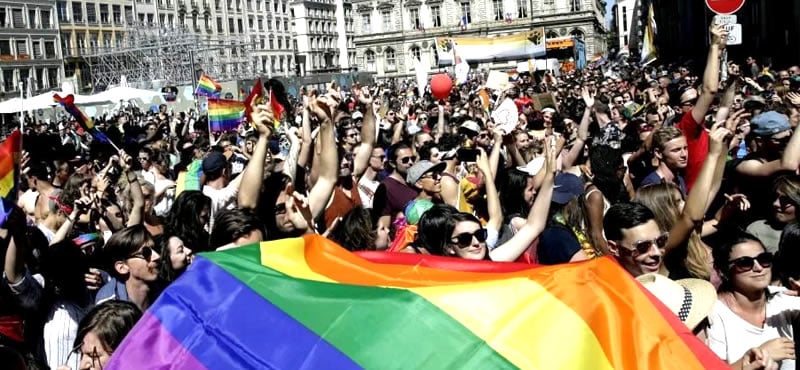The L Bar vs La Chapelle Café
The L Bar La Chapelle CaféI had
already been to these two bars more than once, but going back with the specific
lens of either bar serving the LGBTQIA+ community in a specific way made the
experience completely different.
The first time I visited the L Bar and the La Chapelle Café, it was the
weekend before Pride, and both bars went all out with their lights and
decorations. The L Bar didn’t seem to
change too much, compared to visiting this last weekend. There may have been less tabletop décor, but
it was a minimal change for Pride. La
Chapelle Café, however, had rainbow lights outside the bar where the blue and
purple ones are in the image above. One
thing was for sure about these two bars, however: it was beyond obvious that
these were queer spaces. The L Bar took
every opportunity to remind me that this was the first lesbian bar in Lyon (and
some sources said only lesbian bar in Lyon), and La Chapelle Café had
the flags and lights going crazy the first night I was there. While La Chapelle Café brought it down a bit
more after Pride Month, the L Bar did no such thing.
The
L Bar gave off intimate and personal vibes.
The tables and chairs were all close together, and there were only about
four bar stools, encouraging patrons to sit with other people, either inside or
outside. This particular bar was not on
a main road, but on a side street off the main road. Therefore, the neighboring businesses either
weren’t busy or were closed. This meant
an almost completely empty street…until you got to this bar. The gentle glow of the wall lights hanging
lights outside and the plants growing from the ceiling gave the impression that
this was something of a hidden gem, something that maybe not everyone knew, or had
even heard about. The soft chatter of the
patrons and some unexpected loud laughter from a table somewhere off in the crowd
gave me that unexplainable feeling of a family-like community.
I
got the impression that The L Bar was The Place To Be for some of the people
there. Several patrons sat and talked
and laughed as if this was a regular occurrence, as if that was their typical seating
arrangement, as if they knew the staff personally and by name. It was a strangely isolating feeling, though
I knew that places like this are needed in the LGBTQIA+ community. That feeling did not linger, however, as talking
to the bartender with my friend who didn’t speak French all that well was not
as nerve-wracking as I thought it would be.
The bartender was incredibly patient over the noise and language
barrier, and we ended up having a great time.
When I went over this past weekend, it was a similar experience. There were fewer people there than the last
time I had been there, but that was to be expected, as that first weekend was
the one before Pride, and this last visit was the weekend right after Bastille Day. Still, even with the lack of a full house,
the bartender was still incredibly understanding and helpful, and as I sat
there, alone, sipping my beer, that feeling came over me again. The one of acceptance and community and
mutual understanding and experience. I
would imagine that this is the exact purpose The L Bar serves in the queer
community in Lyon: belonging and understanding.
La Chapelle
Café was definitely different. The first
time I went there, they were clearly a gay bar with the rainbow lights and the
fact that several of their patrons were men who looked to be on dates with
other men. When I went this past weekend
however, the vibe had shifted. I’m not
sure if it was to do with the month and said theme or if it’s because of the Bastille
Day timing, but it didn’t feel as much of a space for the queer community as it
did the first time. I honestly don’t
have much to say about this bar. The
last time, it just felt like a bar. There
were some people trying to dance on the small, cleared space inside, there were
groups of people sitting outside at tables, people standing and talking to
friends, it just felt like the other bars I had been to. I have a feeling that this bar specifically
advertises itself as queer during Pride month but slides back into
heteronormativity afterwards. So, during
June, I would say that it serves the queer community in Lyon quite well but
doesn’t serve said community after that month is over. It's still advertised as a gay bar, but I
didn’t see much evidence of that when I was there this past weekend.
With the United
States, I feel like both of these bars are represented there are well. There are definitely bars in the U.S. that
feel like a small community of queer people and it feels like a cozy, homey
place to be on a Saturday night. But
there are also bars that only express their queer roots and patron-base during
Pride Month, and then backs off after that month is over. I honestly liked both bars, however I do
think that they serve different purposes.
Both places are good to go if you want to have a good time and have a
drink with your friends, but The L Bar is going to be more inclusive, in my
opinion. La Chapelle Café is definitely
fun, but if you’re looking for an explicitly queer bar, going there in June is
your best bet.
word count: 940





